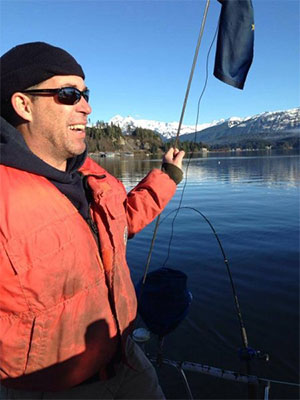
Genetic research may help trace chum salmon to home riversBy LAUREN FRISCH
December 01, 2016
Mapping out chum salmon pathways could help improve management of the pecies in Western Alaska, according to University of Alaska Fairbanks College of Fisheries and Ocean Sciences postdoctoral fellow Michael Garvin. “In some years, chum salmon are frequently the bycatch of pollock fishermen” in the Bering Sea, Garvin explained. “Genetically, chum salmon that originate in Western Alaska tend to look very similar. This makes it difficult for stakeholders because management and conservation efforts to address this bycatch can differ among these regions, but the ability to identify them with genetics is not possible.” Garvin, College of Fisheries and Ocean Sciences professors Megan McPhee and Tony Gharrett, and colleagues used small variations in the DNA of a cell’s mitochondria, the powerhouse of the cell that is involved in energy production, to learn about a salmon’s history. Mitochondria are incredibly important to our bodies. Without our bones, Garvin said, mitochondria make up about one third of our weight. And mitochondria have their own DNA. “When people talk about DNA, they tend to be talking about DNA in a cell’s nucleus,” Garvin said. “DNA in the mitochondria is totally separate.” The changes or mutations in mitochondrial DNA are what people typically use to trace their ancestors back to the earliest human populations. Mitochondrial DNA is useful for this because we inherit it from our mothers, so we can trace a particular genealogy back through time. Mutations can cause physiological changes in an individual that can make them more or less able to adapt to a particular environment. Garvin and McPhee mapped out where different mutations occur in chum salmon’s mitochondrial DNA. Then they used this information to begin to learn about DNA in the nucleus. Even though the two sources of DNA are separate, they must work together for a cell to function properly. The researchers found that changes in mitochondrial DNA enabled detection of corresponding change in the DNA of the nucleus. This uncovered new genetic markers that agencies can now use to improve their ability to determine the natal rivers of salmon in waters off Western Alaska. This effort has been ongoing for 30 years, Garvin said, but is now possible to tackle because of new and less expensive sequencing technology. “New technology has moved so fast that we can now determine what mutations actually do,” Garvin said. “We can look at genetic sequences and understand more about why certain individuals can thrive in one region, but not another.” The researchers are based at the CFOS Lena Point Fisheries Facility near Auke Bay north of Juneau. This project was funded by the Coastal Impact Assistance Program and was conducted in partnership with the Western Alaska Salmon Coalition, the Alaska Department of Fish and Game, and the National Oceanic and Atmospheric Administration Ted Stevens Marine Research Institute at Auke Bay.
This column is provided as a public service in cooperation with the UAF research community by the University of Alaska Fairbanks.
Representations of fact and opinions in comments posted are solely those of the individual posters and do not represent the opinions of Sitnews.
|
|||
